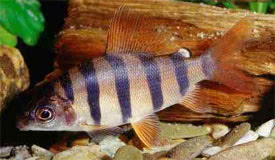
 Magyarul / Hungarian
Magyarul / Hungarian



- Scientific name: Synodontis ornatipinnis
- Synonyms: -
- Common name: Barfin Synodontis, White-Barred Synodontis
- Group: Catfishes
- Habitat: Africa; Zaire (Congo).
- Size: 40 cm, usually 15-20 cm in aquaria.
- Biotope: Inhabits in the turbulent waters of the Congo River.
- Social behavior: Do not keep with small fishes, as they may be eaten. Very territorial as the fish matures, especially towards other Synodontis. Can be kept with large African cichlids in a community tank.
- Diet: Omnivorous; Not a fussy eater, frozen, live and dried foods are readily accepted, and they also need some vegetables. Reported to eat snails in the aquarium.
- Breeding: Unsuccessful in aquaria.
- Tank: Minimum 200 litres
- Population: 1 fish for 200 litres.
- Decoration: Use fine, dark gravel substrate and provide many hiding places of rocks and bogwood. The tank should have a strong current. They do not like bright light, so use some floating plants to dim the lighting.
- Temperature: 22-25 °C
- pH: 6.5-7.5
- Hardness: 8-18 NK°
- Lifespan: 10 years
Description: The dorsal fin and pectoral fins have a hardened first ray which is serrated. The large caudal fin is deeply forked, with pointed lobes. Synodontis ornatipinnis has 3 pairs of barbels on its short head, extending from the mouth. The eyes are large and located high up on the head. Half-grown to adult specimens have irregular, broad dark grey bands or spots on a light grey to grey-brown base coloration on the body. The head exhibits smaller dots or narrower stripes. The fins exhibit transverse stripes. Juveniles have around 6 broad dark brown to black transverse stripes on the body, which subsequently fragment. They are similar in appearance to Synodontis brichardi. A nocturnal catfish.
Breeding has not been accomplished in aquarium.



















